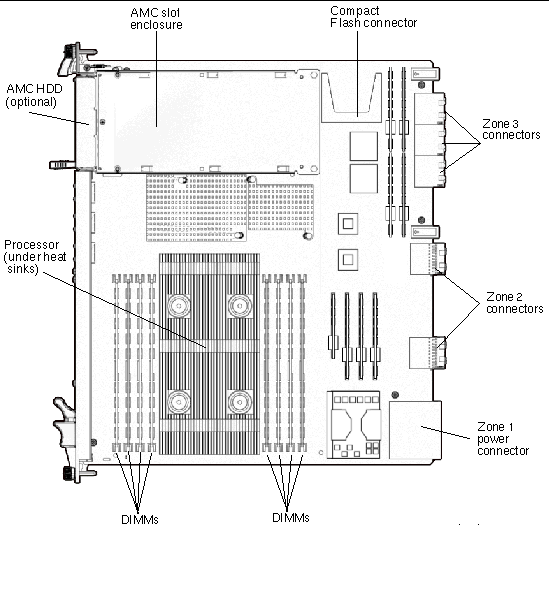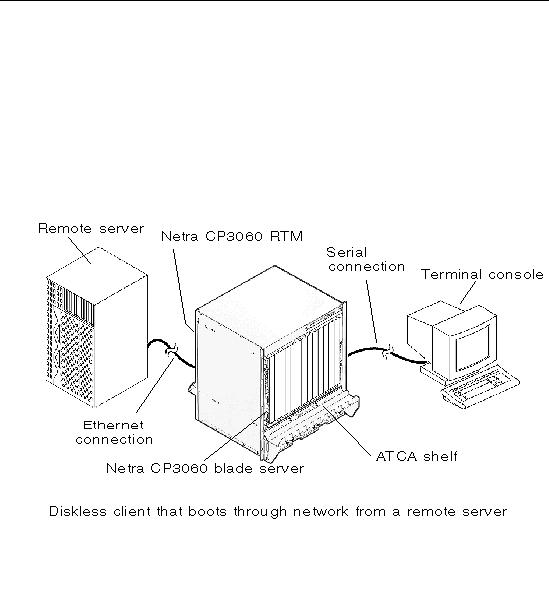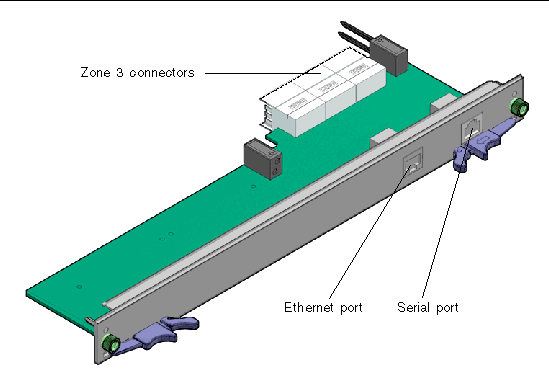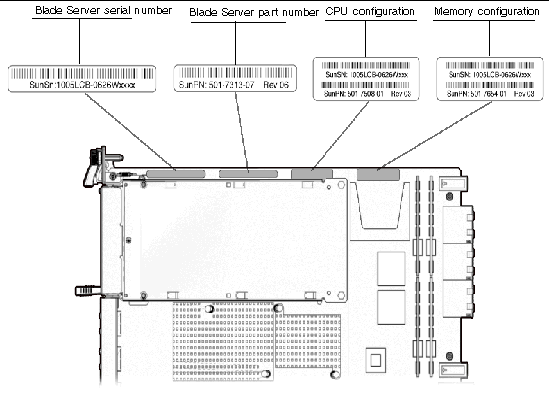Introduction to the Sun Netra CP3060 Blade Server
|
This chapter contains the following sections:
1.1 Overview of the Sun Netra CP3060 Blade Server
The Sun Netra CP3060 blade server is a high-performance single-blade server computer based on one UltraSPARC® T1 multicore processor and designed for high availability in a switched network computing environment. This blade server is compliant with Advanced Telecom Computing Architecture® (ATCA) specifications (PICMG® 3.0 and PICMG 3.1) and can achieve greater performance levels than compactPCI (cPCI) standards-based products targeted for telco markets.
The PICMG (PCI Industrial Computer Manufacturers Group) standards committee has developed the new ATCA (or PICMG 3.x) standard to address the issues posed by previous standards based on cPCI and cPSB (PICMG 2.x). The PICMG 3.x specification brought the following changes to the existing PICMG 2.x family of products:
- Larger board space (8U high compared to 6U for cPCI), which allows more features and processing power
- On-board power supplies deriving local power from redundant -48V power from the midplane (rather than separate power supplies)
- 6-HP slot width, allowing greater component height
- Advanced Mezzanine card (AMC) support and options
- Elimination of PCI connectivity between the blade servers in the system and reallocation of connectivity to serial interconnects, eliminating single points of failure
- Mandatory use of Intelligent Platform Management Interface (IPMI) management interfaces
- Flexible user I/O
- Power and thermal management guidelines enforced by the management infrastructure
- Separation of control and data traffic by supporting the Base (PICMG 3.0) and Extended (PICMG 3.1) interfaces
The ATCA standard consists of the PICMG 3.0, PICMG 3.1, PICMG 3.2, and PICMG 3.3 specifications. The Sun Netra CP3060 blade server complies with:
- PICMG 3.0, the base specification that defines the mechanical, power distribution, system management, data transport, and regulatory guidelines
- PICMG 3.1, which builds upon the PICMG 3.0 base specification and the IEEE 802.3-2003 standard
1.2 Features of the Sun Netra CP3060 Blade Server
The Sun Netra CP3060 blade server provides two 1000BASE-T Ethernet interfaces for the Base interface (a requirement of PICMG 3.0) and two serializer, deserializer (SERDES) gigabit Ethernet interfaces (PICMG 3.1) for the Extended interface. The Base interface is used as the control interface and the Extended interface can be used for data traffic. Both Base and Extended interfaces are configured as Dual Star topologies.
Sun Netra CP3060 blade server features include:
- Single-wide ATCA module
- Compliant with PCIMG3.0/3.1 specification
- UltraSPARC T1 4-core, 6-core, or 8-core, 1.0-GHz processor
- Service processor (MPC885) for CPU reset, boot, partition, and fault management architecture (FMA)
- Memory subsystem
- Eight standard DDR-2 Very Low Profile (VLP) DIMM sockets
- 200 MHz DIMMs, buffered and registered with error-correcting code (ECC)
- Up to 16 Gbytes of DIMM memory with 2-Gbyte DIMMs
- JBus-to-PCI-E application-specific integrated circuits (ASICs) to bridge processors and the PCI-E I/O subsystem
- Two on-board 1000BASE-T Ethernet interfaces used as ATCA Base Interface
- Two on-board 1000 SERDES Ethernet interfaces used as ATCA Extended Interface
- One AMC slot for x8 PCI-E I/O expansion or compatible disk drive
- Compliant with PCIMG AMC.0/.1/.3 specifications
- Two 3-Gbps Serial Advanced Technology Attachment (SATA) ports routed to AMC connector
- Two 10/100/1000 BASE-T Ethernet RJ-45 ports on front panel
- One asynchronous serial port on front panel
- Compact Flash socket to support an 8-Gbyte user flash type I/II memory card
- System management support using Pigeon Point Systems Intelligent Platform Management (IPM) controller, providing a redundant IPMI channel to communicate with the ATCA shelf manager
- Rear I/O access using a compatible Sun Netra CP3060 rear transition module (RTM)
- Maximum power consumption: 200 watts (including Sun Netra CP3060 RTM)
FIGURE 1-1 and FIGURE 1-2 show the Sun Netra CP3060 blade server.
FIGURE 1-1 Sun Netra CP3060 Blade Server Front Panel

|
1 - Top latch
|
6 - Out of Service LED (yellow)
|
|
2 - AMC Hard Disk Drive (optional)
|
7 - OK LED (green)
|
|
3 - Ethernet port A (RJ-45)
|
8 - Hot-Swap LED (blue)
|
|
4 - Ethernet port B (RJ-45)
|
9 - Hot-Swap switch and bottom latch
|
|
5 - Serial port (RJ-45, ttya)
|
|
FIGURE 1-2 Sun Netra CP3060 Blade Server (Top View)

TABLE 1-1 lists features of the blade server.
TABLE 1-1 Feature Summary for the Sun Netra CP3060 Blade Server
|
Feature
|
Description
|
|
CPU
|
- One UltraSPARC T1 processor (4, 6, or 8 core)
- CPU core speed: 1.0 GHz
|
|
Memory
|
- Eight DDR-2 240-pin Very Low Profile (VLP) DIMMs, buffered, registered
- 1-Gbyte or 2-Gbyte DIMMs, for a total memory of 16 Gbytes
- ECC supported
|
|
Power requirement
|
ATCA 3.0 standard of 200 watts maximum
|
|
PICMG compliance
|
- PICMG 3.0 R1.0
- PICMG 3.1 R1.0
|
|
Node board support
|
Functions as a CPU node board with the Solaris software package
|
|
Operating system
|
Solaris 10 6/06 OS and subsequent compatible versions with supported Netra patches
|
|
Internal I/O (connections to ATCA midplane)
|
- Dual gigabit Ethernet for Base interface
- Dual SERDES interface as Extended interface
- Dual IPMI channel connects to the midplane for communicating with the Shelf Management card
|
|
External I/O
|
- Two 10/100/1000 BASE-T Ethernet ports on front panel
- One asynchronous serial port for maintenance on front panel
- One AMC slot with front panel access for AMC I/O
- Rear access support using Sun Netra CP3060 RTM:
- One 10/100 Mbps Ethernet port
- One asynchronous serial port. Access is available in front and rear when RTM is present. Note: Either serial port can be used; but only one of the serial ports can be used at a time.
|
|
AMC I/O
|
Provision for adding an independent hardware vendor (IHV)-supplied AMC disk or PCI-E card on front panel
|
|
IPMI system management
|
Uses IPMI communications with baseboard management controller (BMC); performs advanced system monitoring (ASM) on local board interface (for example, temperature sense, FRU ID, and control)
|
|
Hot-swap support
|
- Basic, full, and high-availability (HA) hot-swap support for node board
- AMC disk/card hot-swap support
|
|
Front panel access
|
- One serial port (RJ-45)
- Two 10/100/1000BASE-T Ethernet ports (RJ-45)
- Cutout for installing AMC without removing blade server from system
|
|
Building compliance
|
Network Equipment Building Systems (NEBS) Level 3
|
|
Flash update
|
Supported from downloaded file
|
| Note - For EMI compliance of front access ports, use shielded cables on all I/O ports. The shields for all shielded cables must be terminated on both ends.
|
1.3 Sun Netra CP3060 Blade Server System Configurations
Sun Netra CP3060 blade servers can be installed in an ATCA shelf (or chassis), shown in FIGURE 1-3. The blade servers can be deployed in various electrical configurations to suit each end-user requirement. For example, the blade server can be configured to boot from a network as a diskless client with either a front panel or RTM network connection, or from an optional Compact Flash card. Alternatively, industry-standard Advanced Mezzanine Card (AMC) hardware from IHVs can be installed to provide local disk I/O, which can be used optionally as a boot path. The Sun Netra CP3060 blade server has fixed on-blade server memory and connectors for additional memory.
FIGURE 1-3 Sun Netra CP3060 Blade Server in an ATCA Shelf Enclosure

1.3.1 AMC Modules
The Sun Netra CP3060 blade server has one AMC slot to provide additional I/O to the front panel. The AMC slot supports AMC-compatible SATA disk drives and PCI-E cards. See Section A.4.2, AMC Connector for more information.
1.3.2 Rear Transition Module
The optional Sun Netra CP3060 RTM installs into the rear of the ATCA enclosure, opposite the Sun Netra CP3060 blade server (see FIGURE 1-5). The RTM connects with the host node board’s Zone 3 rear I/O connectors and includes a serial port and 10/100BASE-T Ethernet port, both with RJ-45 connectors (see FIGURE 1-4).
FIGURE 1-4 Sun Netra CP3060 Rear Transition Module

FIGURE 1-5 shows the physical relationship between the blade server, the rear transition module, and the midplane in a typical ATCA system.
FIGURE 1-5 Relationship of the Sun Netra CP3060 Blade Server, Midplane, and RTM

| Note - When the RTM is used with the Sun Netra CP3060 blade server, shielded cables are required for serial I/O ports. Unshielded cables can be used on Ethernet ports to satisfy EMI compliance standards. The shields for all shielded cables must be terminated on both ends.
|
The customer can order the Sun Netra CP3060 RTM, build a custom card, or buy from an IHV. A minimal set of I/O must provide a boot path for the host board and a path for console I/O to deliver commands and to read board and system status.
Possible boot and console configurations are described in TABLE 1-2. Sun Microsystems provides the Sun Netra CP3060 blade server and a compatible Sun Netra CP3060 RTM. The other configurations require IHV hardware.
TABLE 1-2 I/O Configurations
|
I/O
|
Hardware Required
|
Description
|
|
Ethernet
|
Sun Netra CP3060 blade server
Sun Netra CP3060 RTM (RTM--supplied as an option for rear access)
|
Default boot path uses the Ethernet port; when the blade server runs in diskless client configuration.
|
|
SATA
|
Through the AMC connector
|
SATA devices can be used for local booting.
|
|
Serial data
|
Sun Netra CP3060 blade server
Sun Netra CP3060 RTM
|
Serial port on front panel provides a path for a console I/O.
The serial port can be used on either the Sun Netra CP3060 blade server or Sun Netra CP3060 RTM, but both ports cannot be used at the same time. If the serial port on Sun Netra CP3060 blade server is used, the serial port on the Sun Netra CP3060 RTM should not be used and vise versa.
|
|
Compact Flash
|
Sun Compact Flash card
|
The Compact Flash connector can be used to add an optional 8-Gbyte user flash type I/II memory card.
|
1.4 Hot-Swap Support
This section briefly discusses the hot-swap support on the Sun Netra CP3060 blade server.
There are three hot-swap models described in the PICMG ATCA specification: basic hot-swap, full hot-swap, and high-availability (HA) hot-swap. Refer to the PICMG ATCA Specification, which provides a detailed description of this subject.
This process uses hardware connection control to connect the hardware in an orderly sequence.
1.5 System Requirements
This section contains the system-level hardware and software requirements for the Sun Netra CP3060 blade server.
1.5.1 Hardware Requirements
Sun provides the following items for customer order:
- Sun Netra CP3060 node blade server
- Sun Netra CP3060 RTM (optional)
The RTM enables rear system I/O access to the network, to a boot device, and to a console terminal (shown in FIGURE 1-4). Refer to the Sun Netra CP3060 Rear Transition Module User’s Guide (819-6689) for more information.
The Sun Netra CP3060 RTM is optional and must be ordered separately.
- Compact Flash card (optional)
An IDE Compact Flash card is optional and must be ordered separately.
Acquire the following components, if needed:
- Serial terminal or terminal emulation for console output.
- Cables for terminal and network connections.
- The Sun Netra CP3060 RTM and the AMC disks and PCI-E cards are optional.
TABLE 1-3 lists ATCA and other minimum requirements met by the Sun Netra CP3060 blade server.
TABLE 1-3 ATCA and Other Minimum Requirements Met By the Sun Netra CP3060 Blade Server
|
Requirements
|
Sun Netra CP3060 Node Blade Server
|
|
ATCA system enclosure for 8U boards (includes chassis, midplane, power supply)
|
Yes
|
|
Console output device or serial terminal
|
Yes
|
|
Boot device (such as hard drive, network, or Compact Flash card)
|
Yes
|
|
Peripheral device for network access
|
Yes
|
|
Intelligent Platform Management Controller (IPMC)
|
Yes
|
1.5.2 Software Requirements
The Sun Netra CP3060 blade server supports the following versions of the Solaris OS:
- Solaris 10 OS and subsequent compatible versions
Refer to the Sun Netra CP3060 Blade Server Product Notes (819-4966) for more Solaris OS information, including a list of the required Netra software patches. You can view and download the latest version of this manual at the following web site:
http://www.sun.com/documentation
1.6 Technical Support and Warranty
Should you have any technical questions or support issues that are not addressed in the Sun Netra CP3060 blade server documentation set or on the web site, contact your local Sun Services representative. This hardware carries a one-year return-to-depot warranty. For customers in the US or Canada, call 1-800-USA-4SUN (1-800-872-4786). For customers in the rest of the world, find the World Wide Solution Center nearest you by visiting our web site:
http://www.sun.com/service/contacting/solution.html
When you call Sun Services, be sure to indicate if the Sun Netra CP3060 blade server was purchased separately and is not associated with a system. Have the proper blade server identification information ready. Be prepared to give the representative the blade server part number, serial number, and date code (see FIGURE 1-6).
1.6.1 Blade Server Part Number, Serial Number, and Revision Number Identification
The Sun Netra CP3060 blade server part number, serial number, and revision can be found on labels located on the card (see FIGURE 1-6). The Sun barcode labels provide the following information:
- SunSN - Sun serial number (for example, 1005LCB-0626WM001M)
- SunPN - Sun part number and dash number (for example, 501-7658-01), -01 is the dash number
- Rev - Revision number of the part (for example: Rev 06)
The Media Access Control (MAC) address label contains the MAC address for the blade server in printed and barcode form.
FIGURE 1-6 Sun Netra CP3060 Blade Server Barcode Labeling

| Note - You might find the labels shown in FIGURE 1-6 on other locations on your blade server. Your particular blade server configuration might also appear different from the illustration.
|
| Sun Netra CP3060 Blade Server User’s Guide
|
819-4967-11
|
   
|
Copyright © 2009 Sun Microsystems, Inc. All rights reserved.





